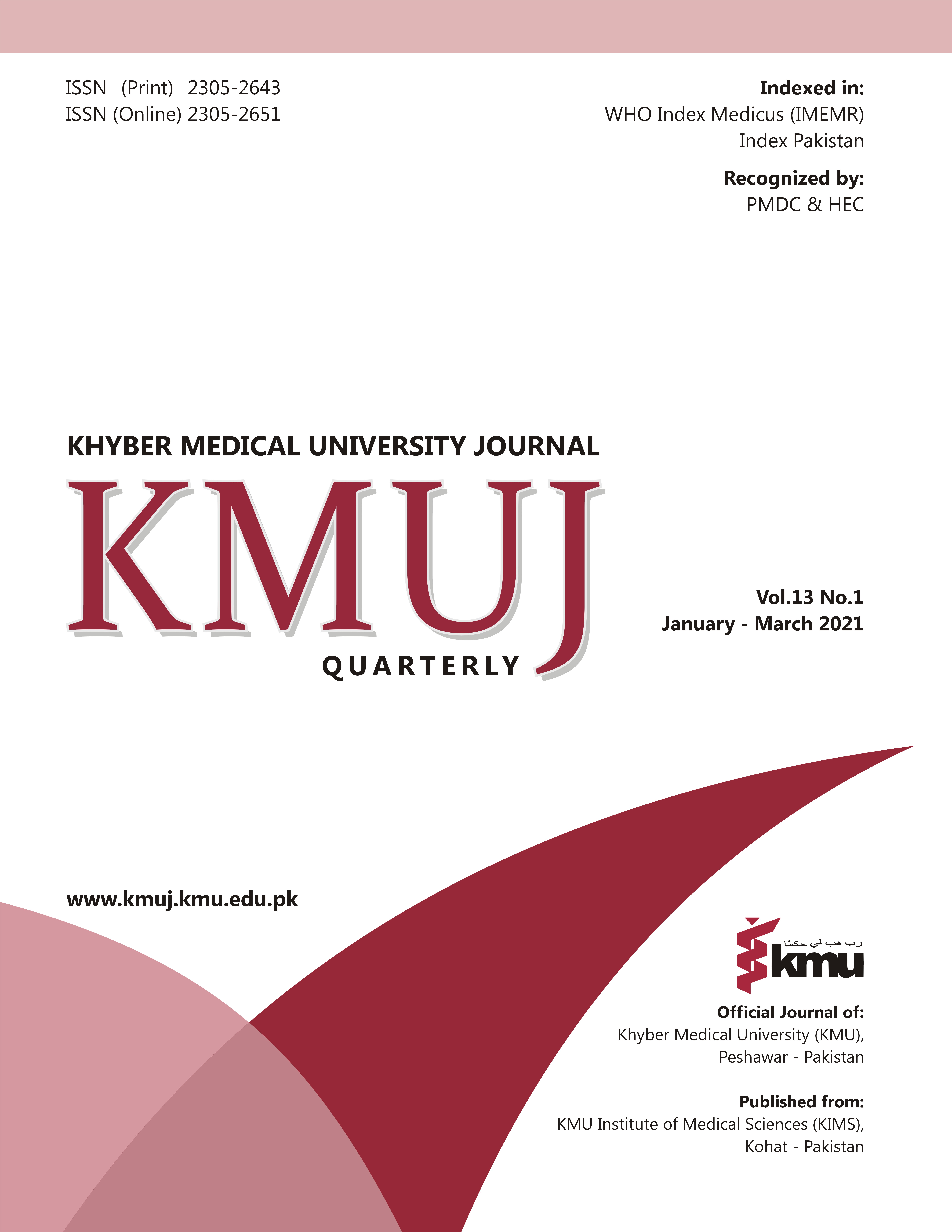ROLE OF CONVENTIONAL PLAIN X- RAYS IN UPPER AERODIGESTIVE TRACT FISH BONE IMPACTION
Main Article Content
Abstract
OBJECTIVE: To assess the role of conventional plain X-rays in managing fish bone impaction in throat, after eating commonly consumed species of fish in Pakistan.
METHODS: This cross-sectional descriptive study was conducted at Combined Military Hospital Muzaffarabad, Pakistan. X-ray of bones from eight different species of commonly eaten fish were taken (in-vitro) and then compared to X-ray of same bone kept in oral cavity of a volunteer (in-vivo), in order to assess the effect of soft tissue and bony super imposition on radio opacity of fish bone and its clinical impact. The radiographs were taken using Siemens 500 MAS machine with an exposure of 65 KV for adults. Both the in vitro and in vivo radiographs were reviewed by thirty doctors of varied echelons ranging from interns to consultants of varying specialties (ENT, Radiology, Internal medicine, general surgery).
RESULTS: Bones of seven fish species were 100% identified on in- vitro film while one fish type (drum fish) was identified by 93.3% (n=28/30) observers. Whereas, in-vivo identification of same bones ranged from 0.00% to a maximum of 33.33%. On in-vivo films, the maximally visualized fish bones were Mahseer and Butter fish (n=10/30; 33.3% each) followed by Catla/Indian carp, Eel, Pomfret and Cobia (n=5/30; 16.6% each). Croaker /drum fish could not be visualized by any observer on in-vivo films.
CONCLUSION: Conventional plain X-rays alone cannot be relied upon for diagnosing fish bone impaction in upper aero-digestive tract.
Article Details
Work published in KMUJ is licensed under a
Creative Commons Attribution 4.0 License
Authors are permitted and encouraged to post their work online (e.g., in institutional repositories or on their website) prior to and during the submission process, as it can lead to productive exchanges, as well as earlier and greater citation of published work.
(e.g., in institutional repositories or on their website) prior to and during the submission process, as it can lead to productive exchanges, as well as earlier and greater citation of published work.
References
Prakash A RB, Rais P, Baskota D, Sinha B. Role of plain xray soft tissue neck lateral view in the diagnosis of cervical esophageal foreign bodies. Internet J Otorhinolaryngol 2008;8(2):1-5.
Devarajan K, Voigt S, Shroff S, Weiner SG, Wein RO. Diagnosing fish bone and chicken bone impactions in the emergency department setting: measuring the system utility of the plain film screen. Ann Otol Rhinol Laryngol 2015 Aug;124(8):614-21. DOI: 10.1177/0003489415573072.
Puthumanakunnel AM, George S. Clinical presentation and treatment outcome in patients presenting with foreign body in ear, nose and throat-a three-year tertiary hospital experience. J Evol Med Dent Sci 2018;7(2):146-8. DOI: 10.14260/jemds/2018/32.
Kumar S, Yu C, Toppi J, Ng M, Hill F, Sist N. The Utility of Diagnostic Imaging in Fish Bone Impaction. Open J Radiol 2018;8(01):45. DOI: 10.4236/ojrad.2018.81006.
Davies WR, Bate PJ. Relative radio-opacity of commonly consumed fish species in South East Queensland on lateral neck x-ray: an ovine model. Med J Aust 2009 Dec 7-21;191(11-12):677-80. DOI: 10.5694/j.1326-5377.2009.tb03378.x.
Chiluveru P, Kumar A, Chavadaki J. Migratory fish bone complicating as neck abscess. Int J Otorhinolaryngol Head Neck Surg 2018;4(2):588-90. DOI: 10.18203/issn.2454-5929.ijohns20180732.
Mohamad A, Ahmad MZ, Mohamad I. A piercing fish bone through tracheal wall. Int J Hum Health Sci. 2018;2(1):35-7.
Wu E, Huang L, Zhou Y, Zhu X. Migratory Fish Bone in the Thyroid Gland: Case Report and Literature Review. Case Rep Med 2018 Feb 22;2018:7345723. DOI: 10.1155/2018/7345723.
Shetty D, Gay DA. The lateral neck radiograph for an impacted fish bone in the aero-digestive tract: Going back to basics. J Biomed Sci Eng 2012;5(12):826-8. DOI: 10.4236/jbise.2012.512A104.
Sanei-Moghaddam A, Sanei-Moghaddam A, Kahrobaei S. Lateral soft tissue X-ray for patients with suspected fishbone in oropharynx, A thing in the past. Iran J Otorhinolaryngol 2015;27(83):459-62.
Ritchie T, Harvey M. The utility of plain radiography in assessment of upper aerodigestive tract fishbone impaction: an evaluation of 22 New Zealand fish species. N Z Med J (Online) 2010;123(1313): 32-7.
Evans R, Ahuja A, Williams SR, Van Hasselt C. The lateral neck radiograph in suspected impacted fish bones—does it have a role? Clin Radiol 1992 Aug;46(2):121-3. DOI: 10.1016/s0009-9260(05)80316-2.
Kundi NA, Mehmood TJPAFMJ. Diagnostic accuracy of indirect laryngoscopy and x-ray neck in the diagnosis of fish bone impaction in upper aero digestive tract. Pak Armed Forces Med J 2015;65(2):216-20.
Qureshi TA, Awan MS, Hussain M, Wasif M. Effectiveness of plain X-ray in detection of fish and chicken bone foreign body in upper aerodigestive tract. J Pak Med Assoc 2017;67(4):544-7.
Huang Z, Li P, Xie L, Li J, Zhou H, Li Q. Related factors of outcomes of pharyngeal foreign bodies in children. SAGE Open Med 2017;5:2050312117724057. DOI: 10.1177/2050312117724057.
Watanabe K, Amano M, Nakanome A, Saito D, Hashimoto S. The prolonged presence of a fish bone in the neck. Tohoku J Exp Med 2012 May;227(1):49-52. DOI: 10.1620/tjem.227.49.
Sundgren PC, Burnett A, Maly PV. Value of radiography in the management of possible fishbone ingestion. Ann Otol Rhinol Laryngol 1994 Aug;103(8 Pt 1):628-31. DOI: 10.1177/000348949410300809.
Ngan JH, Fok PJ, Lai EC, Branicki FJ, Wong J. A prospective study on fish bone ingestion. Experience of 358 patients. Ann Surg 1990 Apr;211(4):459-62. DOI: 10.1097/00000658-199004000-00012.
Lue AJ, Fang WD, Manolidis S. Use of plain radiography and computed tomography to identify fish bone foreign bodies. Otolaryngol Head Neck Surg 2000 Oct;123(4):435-8. DOI: 10.1067/mhn.2000.99663.
Knight L, Lesser T. Fish bones in the throat. Arch Emerg Med 1989 Mar;6(1):13-6. DOI: 10.1136/emj.6.1.13.
Akazawa Y, Watanabe S, Nobukiyo S, Iwatake H, Seki Y, Umehara T, et al. The management of possible fishbone ingestion. Auris Nasus Larynx 2004 Dec;31(4):413-6. DOI: 10.1016/j.anl.2004.09.007.
Watanabe K, Kikuchi T, Katori Y, Fujiwara H, Sugita R, Takasaka T, et al. The usefulness of computed tomography in the diagnosis of impacted fish bones in the oesophagus. J Laryngol Otol 1998 Apr;112(4):360-4. DOI: 10.1017/s0022215100140460.
